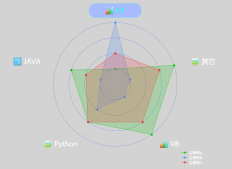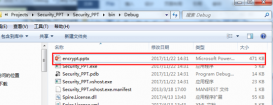本文使用的開(kāi)發(fā)環(huán)境是VS2017及dotNet4.0,寫(xiě)此隨筆的目的是給自己及新開(kāi)發(fā)人員作為參考,
對(duì)于Join的用法說(shuō)明如下:
語(yǔ)法:
|
1
2
3
4
5
6
7
|
public static IEnumerable<TResult> Join<TOuter, TInner, TKey, TResult>( this IEnumerable<TOuter> outer, IEnumerable<TInner> inner, Func<TOuter, TKey> outerKeySelector, Func<TInner, TKey> innerKeySelector, Func<TOuter, TInner, TResult> resultSelector) |
參數(shù)說(shuō)明:
|
1
2
3
4
5
6
7
8
9
10
11
12
13
14
15
16
17
18
|
outerType: System.Collections.Generic.IEnumerable<TOuter>要聯(lián)接的第一個(gè)序列。innerType: System.Collections.Generic.IEnumerable<TInner>要與第一個(gè)序列聯(lián)接的序列。outerKeySelectorType: System.Func<TOuter, TKey>用于從第一個(gè)序列的每個(gè)元素提取聯(lián)接鍵的函數(shù)。innerKeySelectorType: System.Func<TInner, TKey>用于從第二個(gè)序列的每個(gè)元素提取聯(lián)接鍵的函數(shù)。resultSelectorType: System.Func<TOuter, TInner, TResult>用于從兩個(gè)匹配元素創(chuàng)建結(jié)果元素的函數(shù)。返回值Type: System.Collections.Generic.IEnumerable<TResult>IEnumerable<T> ,其類(lèi)型的元素 TResult 通過(guò)對(duì)兩個(gè)序列執(zhí)行內(nèi)部聯(lián)接獲得的。 |
參數(shù)類(lèi)型:
|
1
2
3
4
5
6
7
8
|
TOuter第一個(gè)序列中的元素的類(lèi)型。TInner第二個(gè)序列中的元素的類(lèi)型。TKey鍵選擇器函數(shù)返回的鍵的類(lèi)型。TResult結(jié)果元素的類(lèi)型。 |
參考鏈接如下:
https://msdn.microsoft.com/zh-cn/library/bb534675.aspx
https://docs.microsoft.com/zh-cn/dotnet/api/system.linq.enumerable.join?f1url=https%3A%2F%2Fmsdn.microsoft.com%2Fquery%2Fdev15.query%3FappId%3DDev15IDEF1%26l%3DZH-CN%26k%3Dk(System.Linq.Enumerable.Join%60%604);k(TargetFrameworkMoniker-.NETFramework,Version%3Dv4.0);k(DevLang-csharp)%26rd%3Dtrue&view=netframework-4.7.1
例程:
|
1
2
3
4
5
6
7
8
9
10
11
12
13
14
15
16
17
18
19
20
21
22
23
24
25
26
27
28
29
30
31
32
33
34
35
36
37
38
39
40
41
42
43
44
45
46
47
48
49
50
51
52
53
54
55
56
57
58
59
|
using System;using System.Collections.Generic;using System.Linq;namespace ConsoleApp33{ class Program { static void Main(string[] args) { GroupJoinEx(); } static void GroupJoinEx() { Person p1 = new Person() { Name = "ABC", Age = 18 }; Person p2 = new Person() { Name = "EFG", Age = 19 }; Person p3 = new Person() { Name = "LMN", Age = 20 }; Person p4 = new Person() { Name = "XYZ", Age = 21 }; List<Person> pList = new List<Person> { p1, p2, p3, p4 }; Department d1 = new Department() { Name = "A1", Employee = p1 }; Department d2 = new Department() { Name = "A2", Employee = p2 }; Department d3 = new Department() { Name = "A3", Employee = p1 }; Department d4 = new Department() { Name = "B1", Employee = p3 }; Department d5 = new Department() { Name = "B2", Employee = p4 }; Department d6 = new Department() { Name = "B3", Employee = p4 }; List<Department> dList = new List<Department> { d1, d2, d3, d4, d5, d6 }; var result = pList.Join(dList, person => person, department => department.Employee, (person, department) => new { Person = person, Department = department }); foreach(var item1 in result) { Console.Write($"Name:{item1.Person} & Department:{item1.Department} "); Console.WriteLine(); } } } class Person { public string Name { set; get; } public int Age { set; get; } public override string ToString() { return $"{Name},{Age}"; } } class Department { public string Name { set; get; } public Person Employee { set; get; } public override string ToString() { return $"{Name}"; } }} |
輸出結(jié)果:

對(duì)于GroupJoin的用法說(shuō)明如下:
語(yǔ)法:
|
1
2
3
4
5
6
7
|
public static IEnumerable<TResult> GroupJoin<TOuter, TInner, TKey, TResult>( this IEnumerable<TOuter> outer, IEnumerable<TInner> inner, Func<TOuter, TKey> outerKeySelector, Func<TInner, TKey> innerKeySelector, Func<TOuter, IEnumerable<TInner>, TResult> resultSelector) |
參數(shù)說(shuō)明:
|
1
2
|
outerType: System.Collections.Generic.IEnumerable<TOuter> |
要聯(lián)接的第一個(gè)序列。
|
1
2
|
innerType: System.Collections.Generic.IEnumerable<TInner> |
要與第一個(gè)序列聯(lián)接的序列。
|
1
2
|
outerKeySelectorType: System.Func<TOuter, TKey> |
用于從第一個(gè)序列的每個(gè)元素提取聯(lián)接鍵的函數(shù)。
|
1
2
|
innerKeySelectorType: System.Func<TInner, TKey> |
用于從第二個(gè)序列的每個(gè)元素提取聯(lián)接鍵的函數(shù)。
|
1
2
|
resultSelectorType: System.Func<TOuter, IEnumerable<TInner>, TResult> |
用于從第一個(gè)序列的元素和第二個(gè)序列的匹配元素集合中創(chuàng)建結(jié)果元素的函數(shù)。
返回值
|
1
2
|
Type: System.Collections.Generic.IEnumerable<TResult>IEnumerable<T> ,其中包含類(lèi)型的元素 TResult 通過(guò)對(duì)兩個(gè)序列執(zhí)行分組的聯(lián)接獲得的。 |
參數(shù)類(lèi)型:
|
1
2
3
4
5
6
7
8
|
TOuter第一個(gè)序列中的元素的類(lèi)型。TInner第二個(gè)序列中的元素的類(lèi)型。TKey鍵選擇器函數(shù)返回的鍵的類(lèi)型。TResult結(jié)果元素的類(lèi)型。 |
參考鏈接如下:
https://msdn.microsoft.com/zh-cn/library/bb534297.aspx
https://docs.microsoft.com/zh-cn/dotnet/api/system.linq.enumerable.groupjoin?f1url=https%3A%2F%2Fmsdn.microsoft.com%2Fquery%2Fdev15.query%3FappId%3DDev15IDEF1%26l%3DZH-CN%26k%3Dk(System.Linq.Enumerable.GroupJoin%60%604);k(TargetFrameworkMoniker-.NETFramework,Version%3Dv4.0);k(DevLang-csharp)%26rd%3Dtrue&view=netframework-4.7.1
例程:
|
1
2
3
4
5
6
7
8
9
10
11
12
13
14
15
16
17
18
19
20
21
22
23
24
25
26
27
28
29
30
31
32
33
34
35
36
37
38
39
40
41
42
43
44
45
46
47
48
49
50
51
52
53
54
55
56
57
58
59
60
61
62
63
64
65
66
|
using System;using System.Collections.Generic;using System.Linq;namespace ConsoleApp33{ class Program { static void Main(string[] args) { GroupJoinEx(); } static void GroupJoinEx() { Person p1 = new Person() { Name = "ABC", Age = 18 }; Person p2 = new Person() { Name = "EFG", Age = 19 }; Person p3 = new Person() { Name = "LMN", Age = 20 }; Person p4 = new Person() { Name = "XYZ", Age = 21 }; List<Person> pList = new List<Person> { p1, p2, p3, p4 }; Department d1 = new Department() { Name = "A1", Employee = p1 }; Department d2 = new Department() { Name = "A2", Employee = p2 }; Department d3 = new Department() { Name = "A3", Employee = p1 }; Department d4 = new Department() { Name = "B1", Employee = p3 }; Department d5 = new Department() { Name = "B2", Employee = p4 }; Department d6 = new Department() { Name = "B3", Employee = p4 }; List<Department> dList = new List<Department> { d1, d2, d3, d4, d5, d6 }; var result = pList.GroupJoin(dList, person => person, department => department.Employee, (person, departments) => new { Person = person, Department = departments.Select(d => d) }); foreach(var item1 in result) { Console.Write($"Name:{item1.Person} & "); foreach(var item2 in item1.Department) { if(item1.Department.First() == item2) Console.Write($"Department:{item2} "); else Console.Write($"{item2} "); } Console.WriteLine(); } } } class Person { public string Name { set; get; } public int Age { set; get; } public override string ToString() { return $"{Name},{Age}"; } } class Department { public string Name { set; get; } public Person Employee { set; get; } public override string ToString() { return $"{Name}"; } }} |
輸出結(jié)果:

以上代碼僅在Join與GroupJoin最后一個(gè)參數(shù)有區(qū)別,可以參見(jiàn)紅色字體部分,
并從以上結(jié)果來(lái)看,Join與GroupJoin的區(qū)別一個(gè)在于:Join僅僅是將兩個(gè)結(jié)合進(jìn)行關(guān)聯(lián),而GroupJoin則會(huì)進(jìn)行分組。
總結(jié)
以上所述是小編給大家介紹的C#中使用Join與GroupJoin將兩個(gè)集合進(jìn)行關(guān)聯(lián)與分組,希望對(duì)大家有所幫助,如果大家有任何疑問(wèn)請(qǐng)給我留言,小編會(huì)及時(shí)回復(fù)大家的。在此也非常感謝大家對(duì)服務(wù)器之家網(wǎng)站的支持!
原文鏈接:http://www.cnblogs.com/cncc/p/7985843.html
















